“We’re going out for a while. If any tourists show up, just tell them to wait.”
Yeah, alright, sure…we’ll do that. You can count on us–two random cyclists—to take charge of the Bolivia Immigration Post.
From the Chilean desert town of San Pedro Atacama, where we’d begun the day, it’s a 2,300 meter climb up to the Bolivian border.
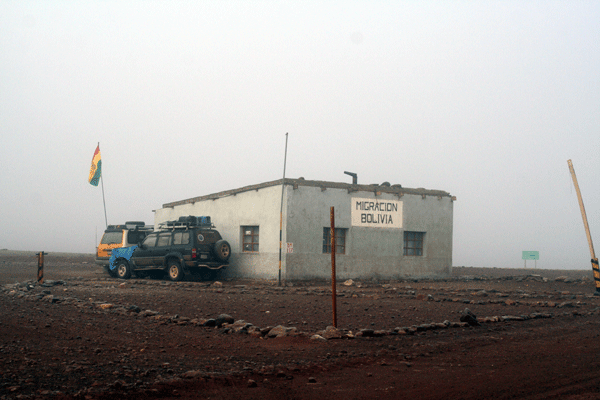
A storm was brewing when we finally lugged ourselves up the grueling ascent. Lightning bolts were illuminating the sky in the valley below.
In Bolivia, cold rain was turning to sleet which would become snow by nightfall.
The Bolivia Immigration Post stands alone on the mountaintop. A simple concrete block building devoid of any modern comforts such as running water, electricity or central heating.
Still, four solid walls create a comparable oasis of warmth. Even without a storm to contend with, nights are frigid at over 4,000 meters.
I guess that’s why the immigration authorities took pity on us and agreed to let us in to spend the night at their humble outpost.
While it was tempting to rummage around in the immigration post, perhaps find out what it feels like to wield the powerful Entry Stamp, we took our duties seriously.
Soon the officers returned, accompanied by a couple of drivers from one of the ubiquitous travel agencies that run tours to this remote corner of Bolivia.
We said our goodnights, Eric and I trotted off to the storeroom, laid out or sleeping bags on a dusty mattress and settled into a cold, fitful sleep.
Judging from the appearance of the kitchen the following morning, the men had settled into a night of drinking. Next to a thawing whole chicken, stood a half-empty bottle of something labeled ‘Potable Alcohol.’ I guess a Bolivian civil servant’s salary doesn’t allow for a more sophisticated path to inebriation.
Unusually for the altiplano, the day shone gray and dreary. Without the sun’s warming rays, the air was bitterly cold. In spite of thick trousers, thermals, a fleece, a wind-breaking jacket, vest, two pairs of gloves, a knitted hat and a balaclava I couldn’t shake the deep chill I felt.
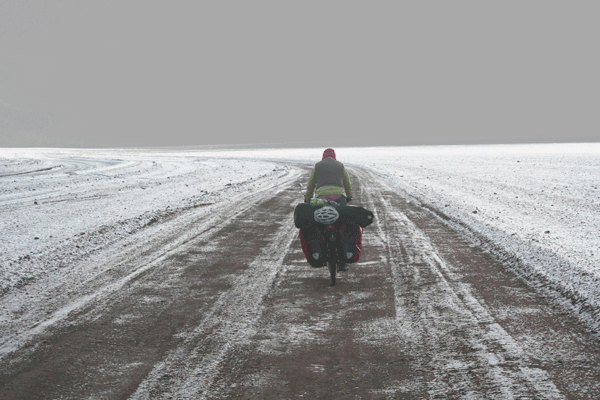
A light dusting of snow covered the bleak landscape. As we rode along I contemplated the tough ride to Uyuni that lay ahead. I knew there were several passes to cross, including Sol de Mañana at almost 5,000 meters. And the road was said to be rough: rocks, sand, washboarding…the usual nightmarish conditions one grows to expect in developing countries.
We’d bought a GPS specifically for this ride, having heard we’d be crossing vast expanses of empty land where getting lost was not only possible, but likely. There would be tracks veering off every which way and a GPS would be our only assurance of making it back to civilization.
Humph. In fact, getting lost in southwestern Bolivia’s Laguna district is about as likely as getting lost on your way to the supermarket.
Thanks to the invasion of the Land Cruisers. They’re everywhere. Ferrying carloads of well-paying tourists from Laguna Verde to the thermal baths at Polques passing by the so-called Dali Desert, then on to the Geysers at Sol de Mañana Pass, and finally on to Laguana Colorada.
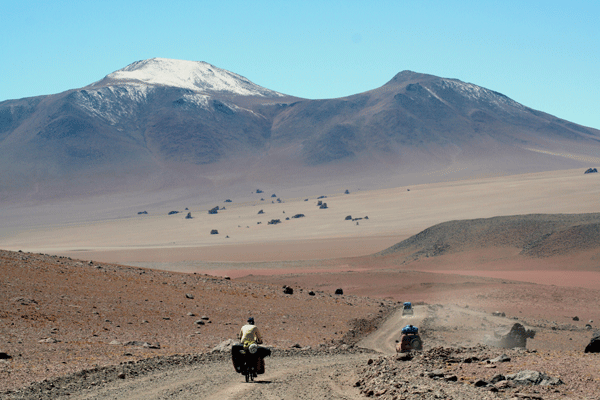
Impossible for even the most directionally-challenged cyclist lose his way with hundreds of Land Cruisers speeding past on the well-worn tracks.
After paying our 150 Bolivano ($22) park entrance fee, we pedal down a sandy track towards Laguna Blanca at the foot of Volcán Licancabur. The mineral-rich lake is suitably beautiful and the pink flamingos are out in full force.
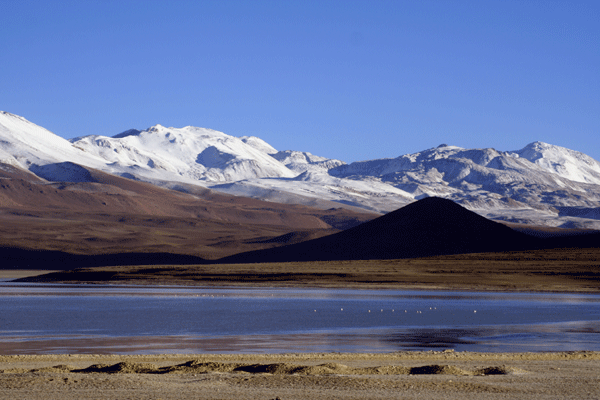
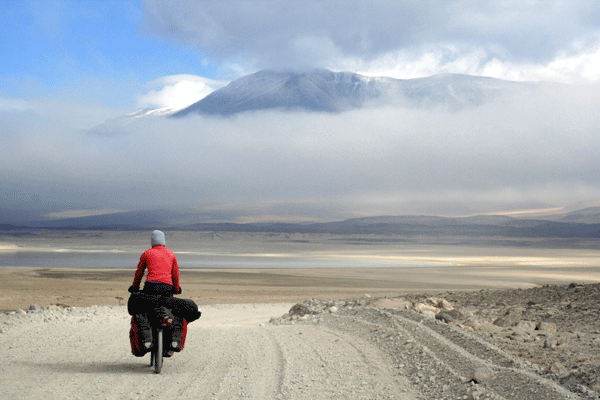
Lingering long is out of the question. Firstly, it’s too damn cold to stop moving, and secondly there’s a high pass looming ahead: Paso del Condor at 4,735 meters. It’s rush hour on the undulating track and the Land Cruisers zoom past one after another, tourists rubber necking to get a look at the two crazy cyclists.
As we gain altitude I begin to feel a familiar thumping in my head, then I become weak, dizzy and unsteady on the bike. Finally I plunk down in the sand.
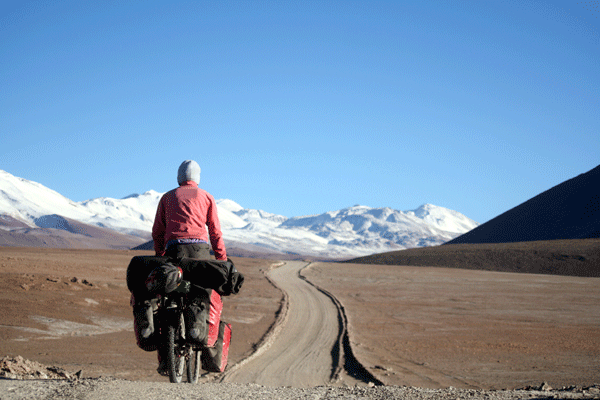
Eric takes one look at me and says we better turn back. I’ve been struck with another bout of altitude sickness.
Backtracking the 10 kilometers to the park entrance is a painstaking process.
At one point, there’s a gentle rise which I find impossible to tackle. I try walking the bike, but that too drains me of energy. Finally, I walk the tiny hill and Eric brings up the bikes.
We’re given a room at the refuge across from the park ranger’s office and I promptly plop into bed, burying myself under a wall of thick woolen blankets.
I feel dreadful but am thankful for a roof over my head. Another storm is brewing and soon I can hear the howling of the wind and the clatter of rain.
Late in the afternoon I’m awoken by the sound of silverware and cheerful chatter. A group of tourists stopping by for lunch. Quick Eric, I plead, go see if they’ve got some leftovers.
“What do you want me to do, go begging like a dog?”
He leaves the room grudgingly but is back in a flash.
“Grab your plate,” he instructs.
I ease myself out of bed and stumble into the dining room to face the group of European tourists, just polishing off what looked to be a very tasty lunch.
The guide is busy scraping potato salad and a huge grilled chicken breast on to Eric’s plate. For me he produces a lovely fresh green salad with juicy tomatoes and a handful of chocolates.
What ecstasy. Of course we’ve stocked up on provisions: Maggi soups, quick-cooking oats, a hunk of salty cheese, several sachets of instant puree, biscuits, saltine crackers, a kilo of rice, 4 bags of pasta, several packets of tomato sauce, some impractical potatoes and three onions.
But this is a real meal we’re being offered. Our dignity may have taken a battering, but at least our stomachs are happily filled.
A few tourists wander over to ask about our trip. Seeing the sorry shape I’m in, a kind Frenchman offers me the last of his Diamox. I take it, gratefully.
Quite stupidly I’d not taken the altitude sickness medicine before the big climb from San Pedro. Somehow I believed I was acclimated after all the high passes we’d crossed coming in from Argentina.
The following morning, Diamox has got my body’s rebellion against the altitude under control.
We set off for a second time from the ranger station, headed again past Laguna Blanca and on to Paso del Condor.
Cycling is far easier than the preceding day. Sure, cycling at an altitude of well over 4,000 meters means I’m wheezing like some lifelong couch potato, but I’m confident we’ll make it. Slow and steady, we are up an over and flying down the other side with a friendly tailwind.
By early afternoon we’d passed the wacky rock formations of the Dali Desert and pulled into the aguas thermales at Polques. Us and about 15 other carloads of yapping tourists.
There were girls with bare-midriffs and super short shorts prancing around after a dip in the hot springs. 17 young English travelers off on a gap year adventure lounging around in the hot pools sipping champagne. And a few staid travelers like us who appeared to find the whole circus slightly distasteful.
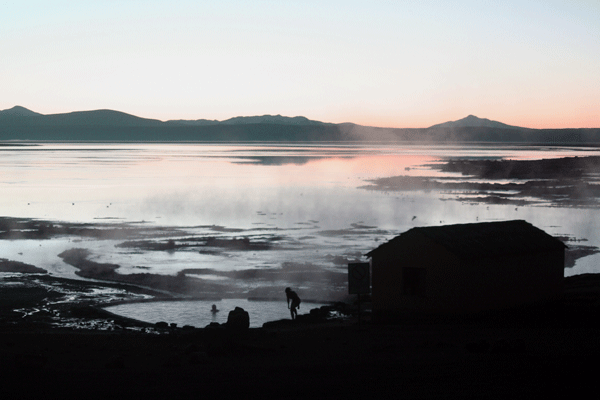
The Southwest Bolivia tourist circuit has become so popular that a restaurant has sprouted up way out there in the middle of nowhere. Which (and I know this is hypocritical) didn’t really bother me since cyclists are kindly allowed to spend the night inside the restaurant. INSIDE in relative warmth and comfort.
Once the last Land Cruiser had finally taken off, we were allowed to push back some tables and roll out the sleeping bags in a corner. Bliss. Pure bliss to escape the elements for another night.
Our slumber was cut short. At 4:00 AM the restaurant staff began gearing up for the surge of tourists expected for sunrise at the thermal baths.
Shortly after 6:00 we are on the road, ready to take on Sol de Mañana Pass. At just over 4,900 meters, we’re expecting a challenge.
While rough road conditions in this part of the world are a constant struggle, wind is the cyclist’s real nemesis.
As we ride past a group of grazing llamas, I feel a light rustling, then a gentle whistling and soon enough we’re battling icy gusts.
There’ll be no peeling off layers of clothing today.
After 15 kilometers I spot what looks to be the top off the pass. After flapping my arms wildly one of the crazed jeep drivers pulls over.
“Is that it? Sol de Mañana Pass?” I ask breathlessly.
The tourists lodged in the back seat are all craning their necks to get in on the conversation.
“Yes, yes, just over there, you’ve almost made it,” the guide assures me.
I’m elated.
Well, I’m elated till I get to the point that is supposedly the top of the pass. Naturally it’s not and we climb another 10 kilometers till we get to the real top of Sol de Mañana pass at 4,918 meters.
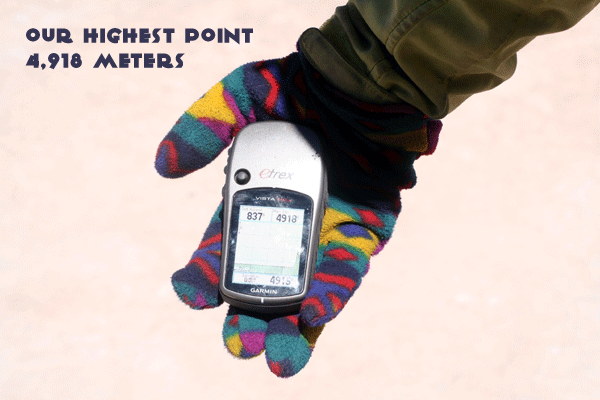
False hopes. Big letdowns. Nasty headwinds. And nothing to do but keep on pedaling.
Finally there’s a descent and soon the flaming-red waters of Laguna Colorada and its flocks of flamingos comes into view.
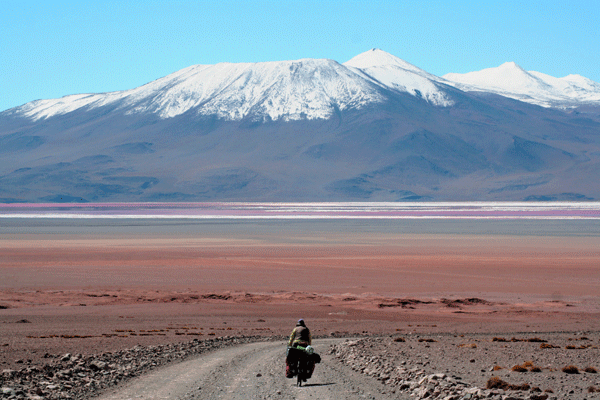
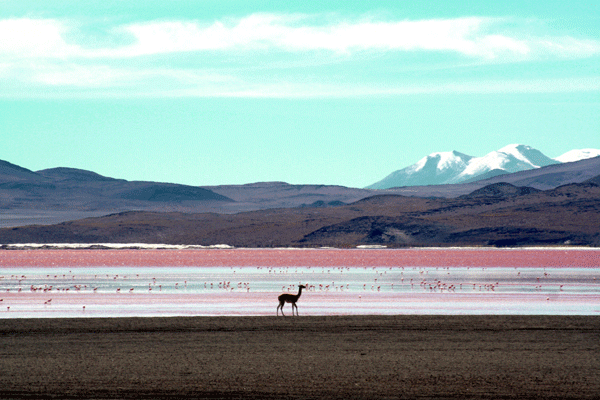
We set up camp for the night across from the park ranger’s station just past the lake. The unrelenting winds turn the simple tasks of pitching the tent and cooking dinner into major undertakings.
I gather discarded bricks to erect a barrier around the stove and the tent pegs are carefully covered with rocks.
We chose our trusty Big Agnes tent not for high-altitude camping, but for the heat of the tropics. We regret now the super ventilation system that allowed in a cooling breeze as we cycled through the sweltering South American lowlands.
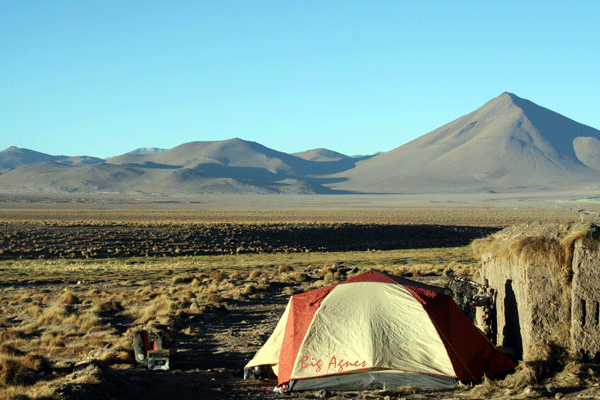
We, and the tent, somehow survive the bitterly cold and windy night.
In the morning we make good time, passing the friendly mining camp before mid-day. Asking about the road ahead, we’re told there’s just one little ‘cerrito’ and then a long descent onto the flat puna.
“Just one tiny hill!” I exclaim. The hard part’s behind us.
Looking back, I’m not sure if the cerrito reference was a cruel joke or just uninformed advice.
There were some very big hills ahead. Steep ones. With sandy surfaces which were impossible to cycle.
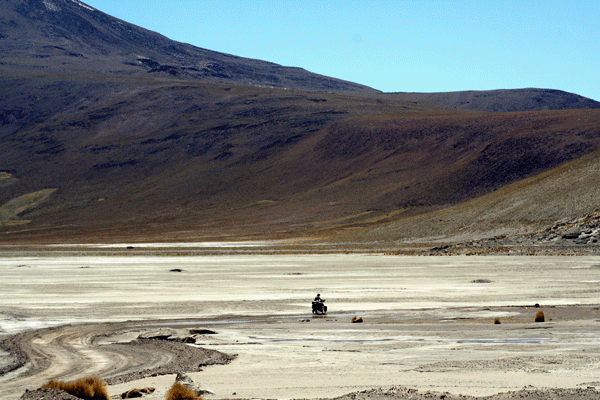
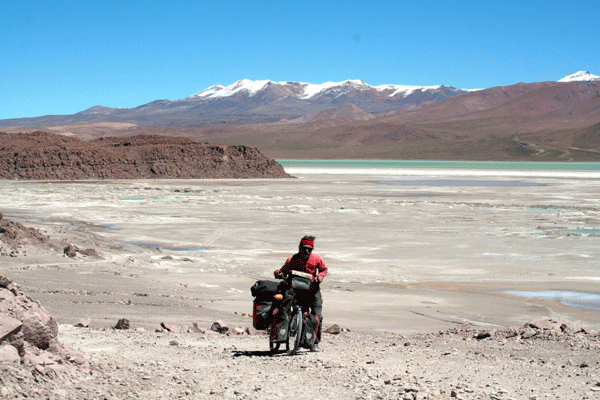
We skirted around the blindingly-white Salar Capina just as the afternoon Land Cruiser rush got into full swing. Naturally, most of the brutes behind the wheel couldn’t be bothered to slow down for two down-trodden cyclists. Hearing the horn blaring in the distance, we’d jump out of the way like peasants allowing the king to pass.
It was late in the day before our suffering finally came to an end with our arrival at Villamar.
A ting adobe village surrounded by llamas. There were shops. And lodging. What more could we want?
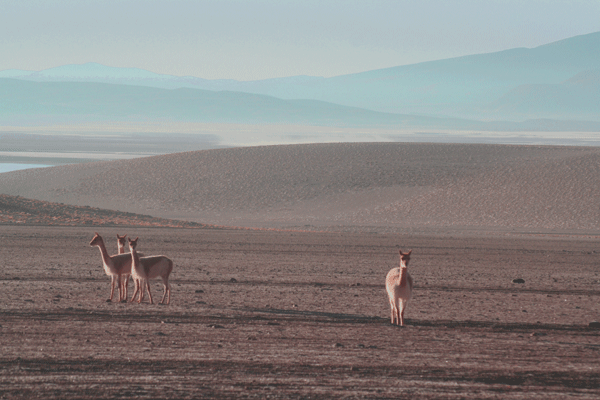
Although I’d not had a shower since we left San Pedro, I didn’t even complain when there was no hot water available for bathing. One more day wouldn’t matter.
We had a comfy bed and blankets. And I was content.
“The road ahead is in good condition. Nothing like where you’ve come from.”
That’s what the earnest-looking shopkeeper in Villamar had promised.
Was this some kind of conspiracy I wondered? The road turned out to be impossible, alternating between sand, washboarding and big rocks.
I’d expected an easy 50 kilometers of gently descending flat puna.
Instead, it took us nearly six hours of concentrated cycling to make it to the next town, Villa Alota.
By then, we were absolutely starving, having consumed the last of our cheese and bread. In Villamar, there’d not been much to choose from in the way of provisions. The usual supply of biscuits and sweets, some tinned food, but nothing fresh, not even bread let alone cheese or vegetables.
Foolishly, we’d counted on finding a nice hot lunch in Villa Alota. At one of the promised comedores.
The village was like a ghost town when we arrived. The dusty streets completely empty and all shops shut up tight. Even the usual stray dogs that wander through all South American towns had taken leave.
I pounded on one of the shop doors and finally a small child cracked open the door and peered out.
“Have you got food? Can you open up?” I demanded in Spanish.
The child just stared back in wonder.
“Where is everybody? I enquired.
Still no response or inkling of understanding.
Finally, just down the road, one of those ubiquitous Land Cruisers came screaming to a halt and a group of tourists piled out. The guide thumped on an imposing metal gate, and like magic it was opened up and the tourists filed inside.
It was Alojamiento Cema. We raced down the road and wandered inside. The tourists were being served a delicious looking meal.
We found the young girl in charge of the hotel/restaurant. “We’d like lunch, too, please.”
She too seemed unable to comprehend our Spanish and just stared at us like we were two aliens asking for her firstborn child. Finally, the tourist guide intervened and explained the situation.
It was time to bring in the quinoa, and all the able-bodied villagers had gone out to the fields for the harvest.
It appeared they’d left the mentally challenged in charge of the village.
No, the girls could not prepare a meal for us. No, the shops would not be opened until the other villagers returned. And no, you cannot have a room.
Wait, wait, wait. A room. We’ve got to have a room.
With a fair amount of persuasion, we were finally ‘allowed’ to rent a room for the night. Food was not forthcoming, so we attempted to fire up the stove for a tasty instant Maggi soup we’d uncovered at the bottom of the food sack.
Primus, why fail us now? The stubborn stove refused to light up, so we resorted to munching on saltines to quell our growing hunger.
Finally, Eric commandeered the kitchen and we were able to prepare our humble meal.
Later, after a thorough cleaning, the stove would begin working again. The villagers would return and the shops would open. The hotel would fill up with several carloads of tourists and there would even be hot showers for all who were willing to pay the extra 10 bolivianos (about $1.50).
We would fill our stomachs with oreo cookies and the Bolivian version of an industrial cupcake. There was still no bread or cheese to buy, but a sugar high has a way of masking one’s suffering.
In two uneventful days we would roll into Uyuni. The promised land.
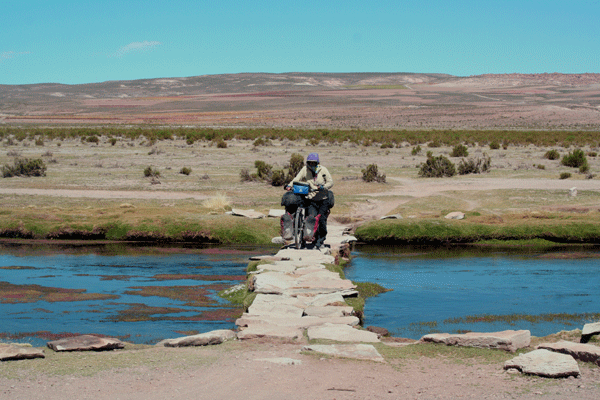
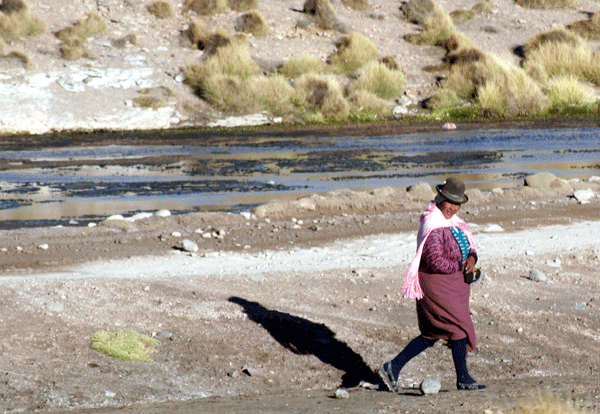
Over a gourmet aubergine-three cheese combo pizza at the American-owned Minuteman Pizzeria, we would laugh about our trials and tribulations on the road from San Pedro.
We would sort through the pictures and be struck by the beauty and desolation of the landscapes. We’d hack and sniffle and sneeze and recall the dreaded cold of the high passes.
We’d think back on all the suffering not with regret, rather with a certain pride that we’d stuck it out.
After a few more days of recovery I think we’ll be ready for the next challenge.


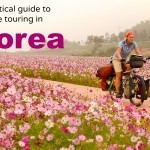
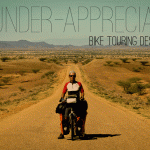
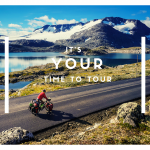
Wow !! what an adventure. Looks like you are definitely enjoying every bit of your time albeit with some discomfort. Can’t wait for the next blog.
I laughed out loud when you said you felt like peasants jumping aside so the king could pass! I love when people share the highs and lows of touring…cycling while low on food is the worst. Glad you kept your spirits up!
Can’t agree more…food is a cyclist’s energy source and cycling without it sucks.